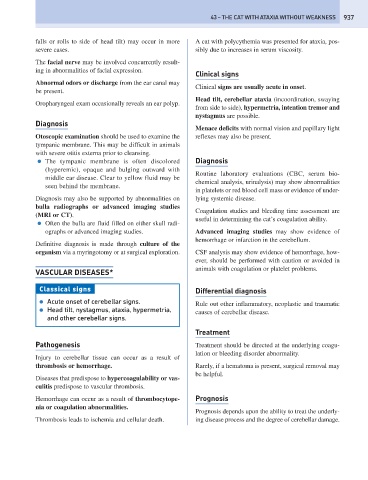Page 945 - Problem-Based Feline Medicine
P. 945
43 – THE CAT WITH ATAXIA WITHOUT WEAKNESS 937
falls or rolls to side of head tilt) may occur in more A cat with polycythemia was presented for ataxia, pos-
severe cases. sibly due to increases in serum viscosity.
The facial nerve may be involved concurrently result-
ing in abnormalities of facial expression.
Clinical signs
Abnormal odors or discharge from the ear canal may
Clinical signs are usually acute in onset.
be present.
Head tilt, cerebellar ataxia (incoordination, swaying
Oropharyngeal exam occasionally reveals an ear polyp.
from side to side), hypermetria, intention tremor and
nystagmus are possible.
Diagnosis
Menace deficits with normal vision and papillary light
Otoscopic examination should be used to examine the reflexes may also be present.
tympanic membrane. This may be difficult in animals
with severe otitis externa prior to cleansing.
● The tympanic membrane is often discolored Diagnosis
(hyperemic), opaque and bulging outward with
Routine laboratory evaluations (CBC, serum bio-
middle ear disease. Clear to yellow fluid may be
chemical analysis, urinalysis) may show abnormalities
seen behind the membrane.
in platelets or red blood cell mass or evidence of under-
Diagnosis may also be supported by abnormalities on lying systemic disease.
bulla radiographs or advanced imaging studies
Coagulation studies and bleeding time assessment are
(MRI or CT).
useful in determining the cat’s coagulation ability.
● Often the bulla are fluid filled on either skull radi-
ographs or advanced imaging studies. Advanced imaging studies may show evidence of
hemorrhage or infarction in the cerebellum.
Definitive diagnosis is made through culture of the
organism via a myringotomy or at surgical exploration. CSF analysis may show evidence of hemorrhage, how-
ever, should be performed with caution or avoided in
animals with coagulation or platelet problems.
VASCULAR DISEASES*
Classical signs Differential diagnosis
● Acute onset of cerebellar signs. Rule out other inflammatory, neoplastic and traumatic
● Head tilt, nystagmus, ataxia, hypermetria, causes of cerebellar disease.
and other cerebellar signs.
Treatment
Pathogenesis Treatment should be directed at the underlying coagu-
lation or bleeding disorder abnormality.
Injury to cerebellar tissue can occur as a result of
thrombosis or hemorrhage. Rarely, if a hematoma is present, surgical removal may
be helpful.
Diseases that predispose to hypercoagulability or vas-
culitis predispose to vascular thrombosis.
Hemorrhage can occur as a result of thrombocytope- Prognosis
nia or coagulation abnormalities.
Prognosis depends upon the ability to treat the underly-
Thrombosis leads to ischemia and cellular death. ing disease process and the degree of cerebellar damage.

